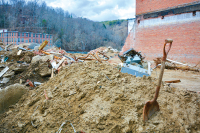Forest Service enhances 128 plans with old growth protections
The U.S. Forest Service has issued a proposal that would amend all 128 forest land management plans in its jurisdiction with language aimed at better maintaining, improving and expanding old-growth forests.
Notes from a plant nerd: Oh balsam tree, oh balsam tree
At the highest elevations of the Southern Appalachians grow two evergreen trees that give the Balsam Mountains their name — red spruce (Picea rubens) and Fraser fir (Abies fraseri).
Namesake chosen for red spruce greenhouse
A namesake has been chosen for the $2 million greenhouse the Southern Highlands Reserve in Lake Toxaway is building to propagate red spruce trees for replanting on the landscape.
Hope for the hemlocks: Hike explores past, present and future of WNC hemlocks
Under the gray, misty November sky covering Panthertown Valley near Cashiers, we swish through shin-deep leaves in search of hemlock trees.
Notes from a plant nerd: Going to seed
Want to hear a corny joke about an oak tree? That was it.
It’s time to grab your hardhat
To the Editor:
As yellow falling leaves and cool, dry air are floating into the mountains, it signals to knowledgeable residents that it’s time to look up.
Plant more trees
The N.C. Forest Service is now accepting tree seedling orders for its annual sale.
Get schooled in the Smokies
Catch a doubleheader in mountain education with a pair of programs offered through the University of Tennessee Smoky Mountain Field School Saturday, Aug. 19.
Red spruce planted at Mount Mitchell
In May, 327 two-year-old red spruce trees grown by the Southern Highlands Reserve in Lake Toxaway traveled to the Black Mountains for planting in Mount Mitchell State Park.
Celebrate birds and old trees
A pair of lectures planned for the Highlands Nature Center over the next couple weeks will explore the complexities of old-growth forests and avian life.





